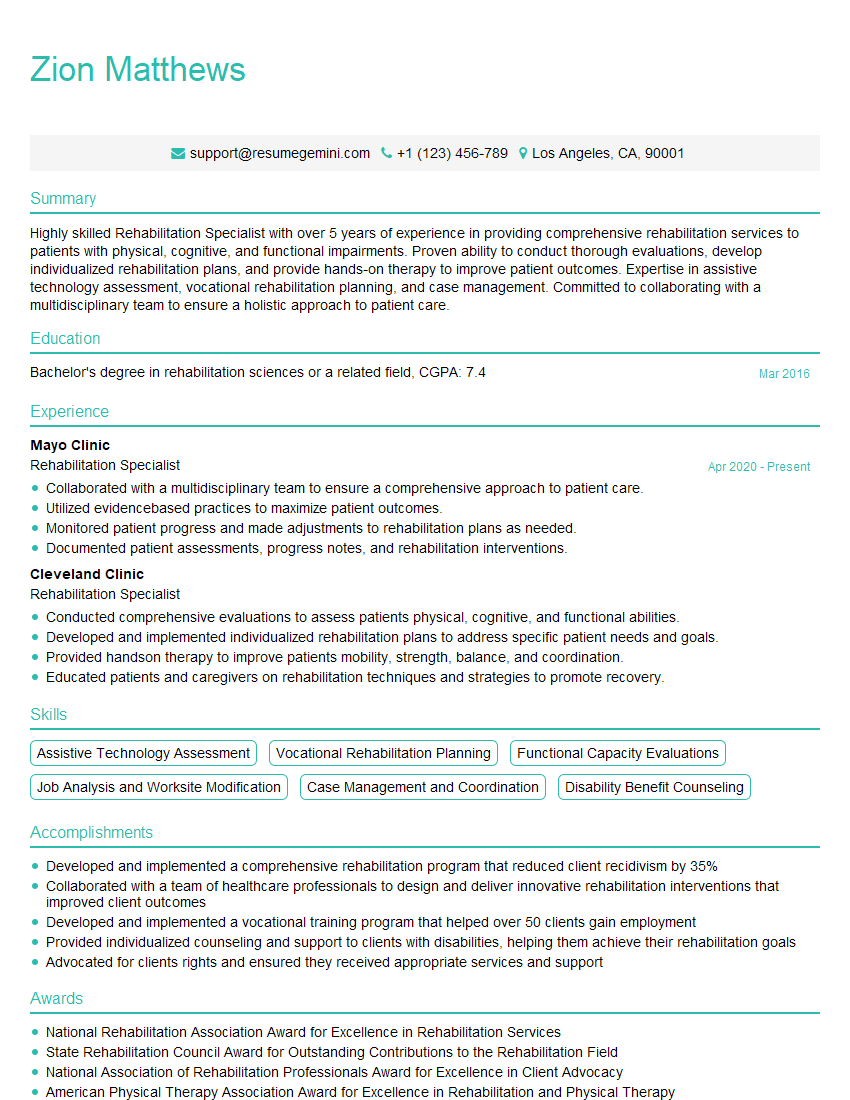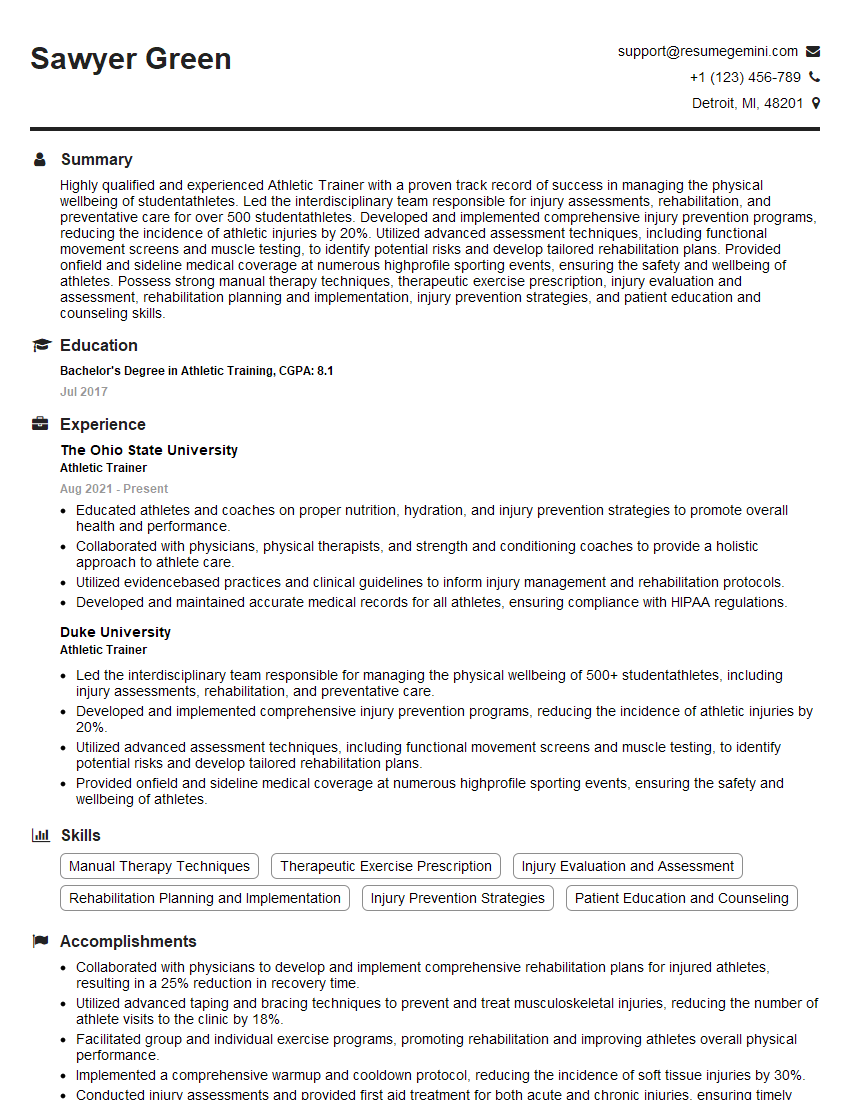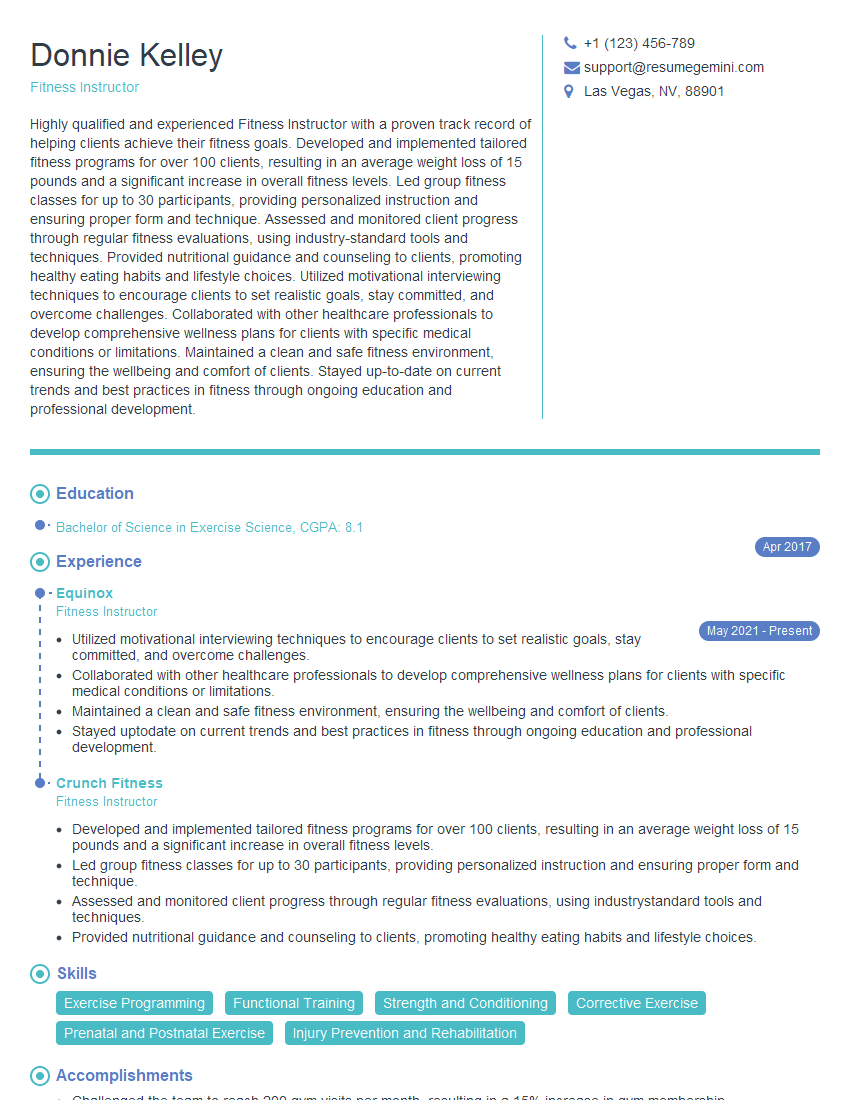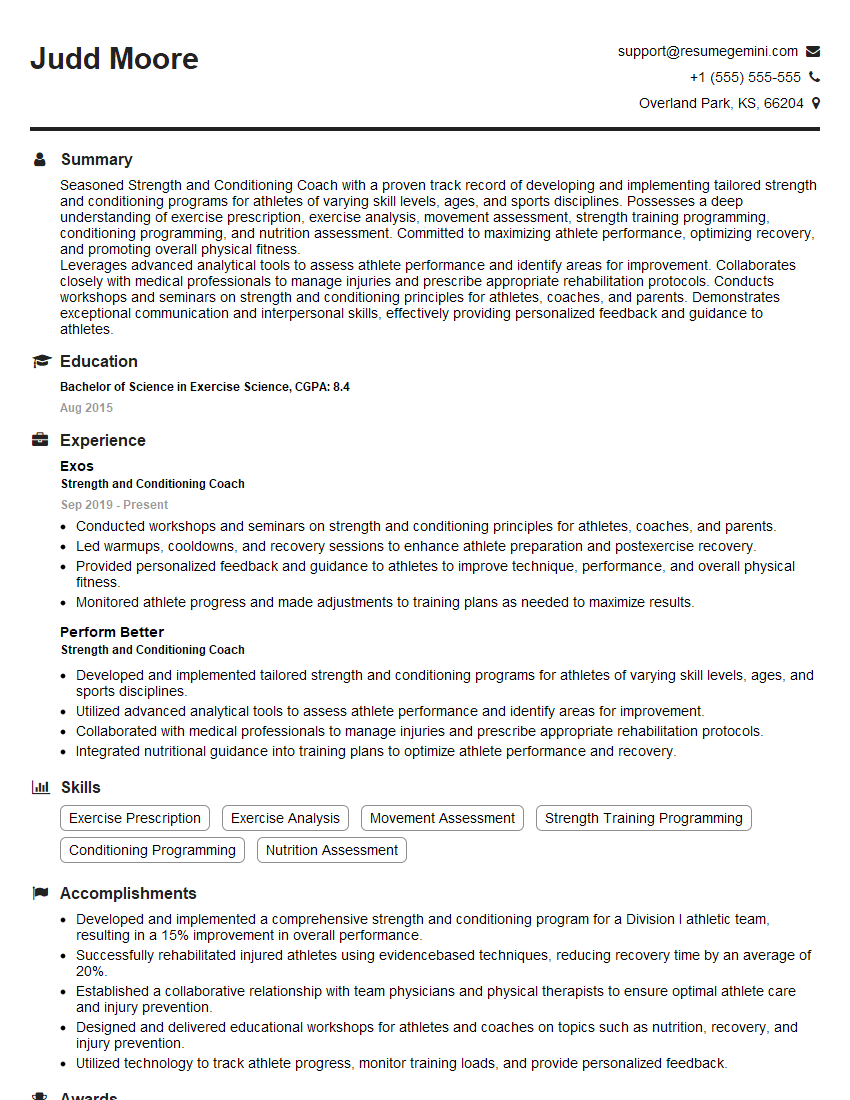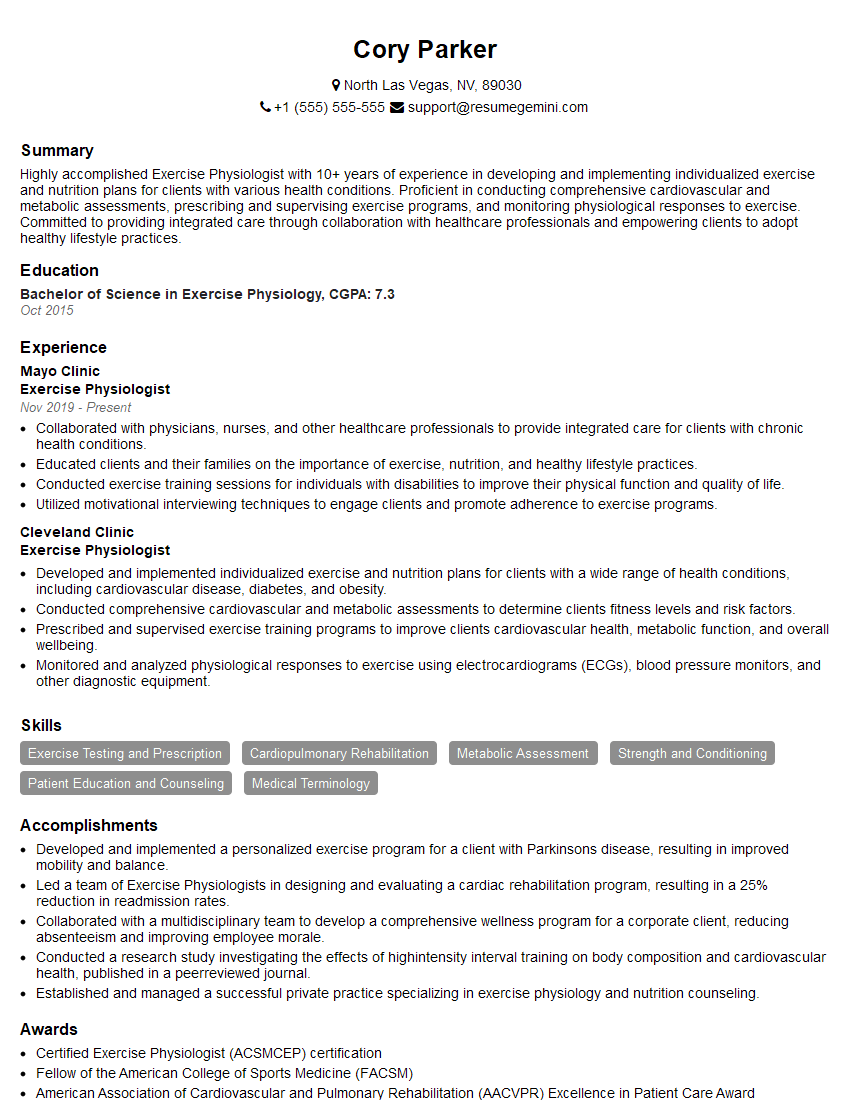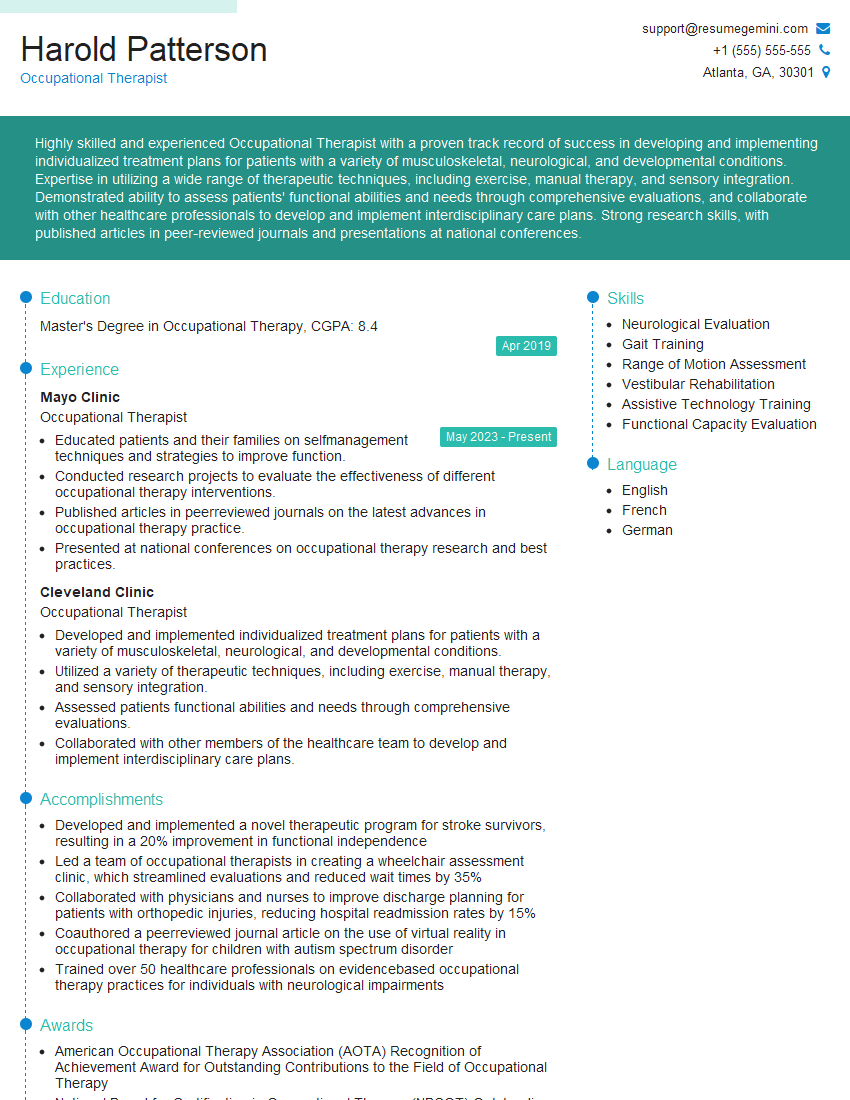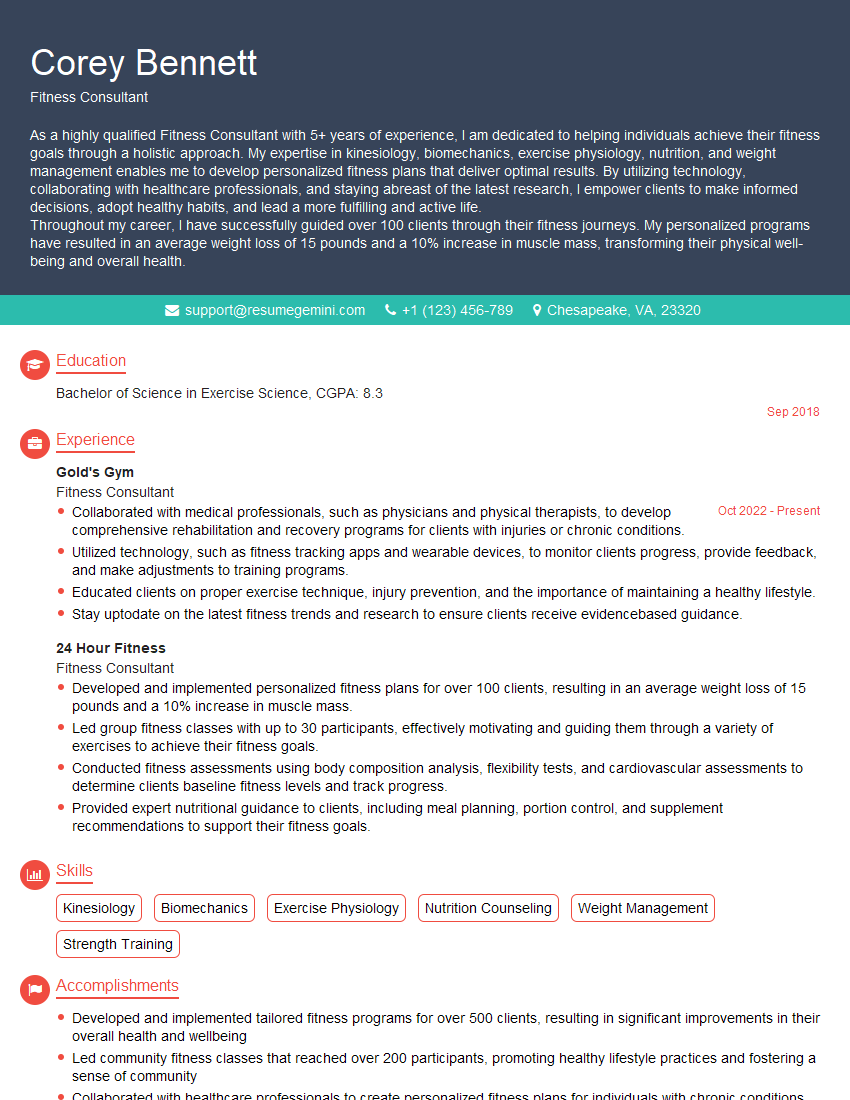Unlock your full potential by mastering the most common Foam Rolling interview questions. This blog offers a deep dive into the critical topics, ensuring you’re not only prepared to answer but to excel. With these insights, you’ll approach your interview with clarity and confidence.
Questions Asked in Foam Rolling Interview
Q 1. Explain the physiological mechanisms behind foam rolling.
Foam rolling, or self-myofascial release (SMR), works through several physiological mechanisms. Primarily, it targets the fascia, a connective tissue that surrounds muscles, bones, and organs. Think of it like a tight, restrictive sweater around your muscles. When this fascia becomes tight or adhered (due to injury, overuse, or inactivity), it can restrict movement and cause pain.
Foam rolling applies pressure to these areas, creating several effects:
- Increased blood flow: The pressure stimulates blood circulation, bringing oxygen and nutrients to the muscles and removing metabolic waste products that accumulate after exercise or injury. This aids in muscle recovery and reduces soreness.
- Reduced muscle stiffness and improved range of motion: By breaking up adhesions and softening the fascia, foam rolling helps improve muscle elasticity and flexibility, allowing for a greater range of motion. Imagine untangling a knotted rope – that’s essentially what foam rolling does to the fascia.
- Neuromuscular effects: The pressure receptors in the skin and fascia are stimulated, leading to changes in muscle tone and potentially reducing pain signals through the nervous system. This is similar to how a massage therapist might work on trigger points (hyperirritable spots in the muscles).
- Improved proprioception: Foam rolling can enhance body awareness and proprioception (your body’s sense of its position in space), as you become more mindful of the tension and stiffness in your muscles.
These combined effects lead to improved muscle function, reduced pain, and enhanced performance.
Q 2. Describe the difference between static and dynamic foam rolling.
The key difference between static and dynamic foam rolling lies in the movement involved.
- Static foam rolling involves holding the roller on a specific muscle group for a period of time (typically 30-60 seconds), applying pressure to the targeted area. Imagine holding a foam roller on your quadriceps and slowly rolling back and forth within a 6-inch range. This focuses on releasing tension and improving flexibility in that particular spot.
- Dynamic foam rolling incorporates movement while using the foam roller. This might involve rolling across a larger muscle group at a more brisk pace or using the roller to facilitate active stretching. Think of a larger range of motion across your entire hamstring using a fast roll. This is more like a warm-up tool, improving blood flow and preparing muscles for activity.
Both methods have their place in a well-rounded foam rolling routine. Static rolling is generally better for addressing specific areas of tightness or trigger points, while dynamic rolling is useful for a pre-workout warm-up or increasing overall muscle blood flow.
Q 3. What are the contraindications for foam rolling?
Foam rolling is generally safe, but there are some contraindications to be aware of. You should avoid foam rolling if you have:
- Open wounds or skin infections: The pressure from the foam roller can aggravate these conditions and lead to further damage.
- Deep vein thrombosis (DVT): Foam rolling could dislodge a blood clot, so it’s crucial to avoid this if you have any suspicion of DVT.
- Recent fractures or surgeries: The pressure could damage the healing bone or tissues, disrupting the healing process.
- Certain medical conditions: Individuals with conditions like severe osteoporosis, advanced arthritis, or cancer should consult their doctor before engaging in foam rolling.
- Acute pain or inflammation: Using a foam roller on an acutely injured area can worsen the inflammation and delay healing.
It’s always best to consult with a healthcare professional or qualified fitness instructor if you have any concerns or pre-existing health conditions before incorporating foam rolling into your routine.
Q 4. How would you assess a client’s needs before recommending a foam rolling program?
Assessing a client’s needs before recommending a foam rolling program requires a holistic approach.
- Movement Assessment: I would observe the client’s posture, movement patterns, and range of motion to identify areas of stiffness or limitations. For example, rounded shoulders or limited hip flexion may indicate areas needing targeted foam rolling.
- Pain Assessment: A thorough assessment of pain is crucial. Where is the client experiencing pain? What are the pain characteristics (intensity, location, duration)? This helps determine the appropriate pressure and duration for foam rolling.
- Medical History: This is vital to identify contraindications. Understanding previous injuries, surgeries, or existing health conditions helps customize the program to avoid any potential risks.
- Activity Level and Goals: A sedentary individual might require a different foam rolling program compared to a highly active athlete. Their goals (increased flexibility, improved recovery, injury prevention) will also inform the design of the program.
- Education Level: I’d assess their understanding of foam rolling to tailor instructions and ensure safety.
Once this assessment is complete, I can create a personalized program focusing on specific muscle groups and addressing the individual’s unique needs and limitations. This ensures safety and efficacy.
Q 5. Explain the concept of self-myofascial release.
Self-myofascial release (SMR) is a technique that uses self-massage to alleviate muscle tension and improve flexibility. Foam rolling is a common method of SMR. The term ‘myofascial’ refers to the muscle and fascia, and ‘release’ indicates the reduction of tension and adhesions within these tissues.
The basic concept is that tight or adhered fascia restricts muscle movement and can cause pain. By applying pressure to these areas, whether through a foam roller, massage ball, or other tools, it’s believed that you can break up these adhesions, improve blood flow, and ultimately reduce pain and improve range of motion. It’s a form of self-treatment, offering a convenient way to manage muscle soreness and improve flexibility.
Q 6. How do you address client discomfort during foam rolling?
Client discomfort during foam rolling is common. It’s important to emphasize that some discomfort is normal, but pain should always be avoided. Here’s how I address client discomfort:
- Education: I clearly explain that the goal isn’t to inflict pain, but to release tension. A sensation of tightness or pressure is expected, but sharp or radiating pain is a warning sign.
- Pressure Modification: I instruct the client on techniques to modify pressure. This could include shifting body weight, adjusting the angle of the roller, or reducing the duration on a particular area.
- Breathing Techniques: Encouraging deep, controlled breathing can help clients relax and reduce the perception of discomfort.
- Alternative Techniques: If an area is particularly sensitive, we may explore alternative techniques like using a tennis ball or massage ball, which allow for more targeted pressure.
- Progressive Overload: I might suggest starting with shorter durations and gradually increasing the time spent on each area as the client’s tolerance improves.
- Proper Body Positioning: Ensuring correct body alignment and technique is crucial to avoid excessive pressure or strain on joints.
It’s important to have an open communication with the client, listening to their feedback and making adjustments as needed.
Q 7. What are the benefits of foam rolling for improving flexibility?
Foam rolling offers several benefits for improving flexibility:
- Reduced Muscle Stiffness: By breaking down adhesions in the fascia, foam rolling helps to improve muscle elasticity and reduce stiffness, leading to a greater range of motion.
- Increased Blood Flow: Improved circulation delivers oxygen and nutrients to the muscles, promoting tissue repair and reducing muscle soreness, thereby allowing for a more comfortable and increased stretch.
- Neuromuscular Changes: Stimulation of pressure receptors may influence muscle tone and lead to improved relaxation, enhancing the ability to achieve deeper stretches.
- Improved Proprioception: As clients become more aware of their muscle tension and range of motion through foam rolling, they can develop better control and coordination during stretching, improving both active and passive flexibility.
Foam rolling, when combined with a regular stretching program, can be a highly effective approach to enhance flexibility and range of motion. It’s important to remember that it’s just one tool in a comprehensive flexibility training plan; it works best in conjunction with other methods like static and dynamic stretching.
Q 8. How does foam rolling affect muscle recovery?
Foam rolling aids muscle recovery by improving blood flow and reducing muscle soreness. Think of it like this: after a workout, your muscles are tight and potentially inflamed. Foam rolling acts as a self-massage, gently breaking up knots (adhesions) in the fascia (the connective tissue surrounding muscles). This increased blood flow delivers oxygen and nutrients to the muscles, speeding up the repair process and reducing the buildup of lactic acid, a key contributor to muscle soreness. The mechanical pressure also stimulates the lymphatic system, helping to remove waste products and reduce inflammation.
Studies have shown that foam rolling can significantly reduce delayed-onset muscle soreness (DOMS) compared to no treatment. However, it’s crucial to remember that foam rolling is a supportive tool, not a replacement for adequate rest, hydration, and nutrition.
Q 9. What are some common foam rolling mistakes to avoid?
Several common mistakes can hinder the effectiveness and even cause harm during foam rolling. One major error is rolling too quickly over tender areas. This can be painful and ineffective. Think of it like trying to knead dough too rapidly – you won’t get a smooth result. Instead, slow, deliberate movements allow the fascia to release.
- Bouncing on the roller: This can cause jarring and increase the risk of injury. Maintain controlled, steady pressure.
- Rolling over joints: Avoid directly rolling over joints like your knees or elbows. Focus on the surrounding muscles.
- Ignoring pain signals: While some discomfort is expected, sharp or intense pain indicates you need to stop or adjust your technique. Listen to your body.
- Focusing solely on painful areas: While addressing sore spots is important, rolling surrounding muscles helps restore balanced tension throughout the body. Neglecting the surrounding areas can lead to compensatory tightness elsewhere.
- Lack of proper breathing: Holding your breath tenses your body, limiting the benefits of foam rolling. Exhale as you roll into a tighter area.
Q 10. How would you modify a foam rolling routine for clients with specific injuries (e.g., lower back pain)?
Modifying a foam rolling routine for clients with specific injuries requires a careful, individualized approach. For example, a client with lower back pain might benefit from focusing on the hip flexors, hamstrings, and gluteal muscles, as tightness in these areas often contributes to lower back issues.
Lower Back Pain Example: Instead of direct back rolling (which can aggravate the injury), we would focus on areas like the hip flexors (lying on your stomach, rolling from the top of the hip towards the groin), and hamstrings (lying on your back, placing the roller under one hamstring and rolling from the knee towards the buttocks). We’d also include the glutes to ensure balanced muscle activation. The routine would need to be gentle and avoid any movements that increase pain. Always recommend consultation with a physical therapist or doctor before starting any new routine, especially if injured.
The key is to identify the contributing muscle imbalances and target those areas with appropriate pressure and controlled movements, while avoiding any exacerbating actions.
Q 11. Explain the role of proper breathing techniques during foam rolling.
Proper breathing is essential during foam rolling. It helps to relax the muscles, allowing for deeper release and reducing muscle tension. Holding your breath tenses your muscles, making the foam rolling less effective and potentially more painful.
The ideal technique is to exhale deeply as you roll into a tighter spot, and inhale as you move to a more relaxed area. This synchronized breathing helps to manage pain and facilitates a deeper release of muscle tension. Think of the exhale as a cue for relaxation, allowing you to release tension both mentally and physically. By consciously controlling your breathing, you can significantly improve the effectiveness and comfort of your foam rolling session.
Q 12. How do you integrate foam rolling into a complete fitness program?
Foam rolling integrates seamlessly into a complete fitness program as part of the warm-up, cool-down, or as a standalone self-care routine.
- Warm-up: Light foam rolling can prepare the muscles for exercise by increasing blood flow and improving range of motion. This helps reduce injury risk.
- Cool-down: Post-workout foam rolling helps to reduce muscle soreness, improve recovery, and prevent stiffness.
- Standalone routine: A dedicated foam rolling session can be done independently to address specific muscle tightness or imbalances.
The ideal time and frequency depends on individual needs and training intensity. Some athletes incorporate foam rolling daily, while others might use it two to three times a week. It’s always best to listen to your body and adjust accordingly.
Q 13. Describe the different types of foam rollers and their uses.
Foam rollers come in various densities, sizes, and textures, each with specific uses.
- High-density foam rollers: These are firmer and provide deeper tissue release, ideal for athletes or individuals with significant muscle tightness. They are more challenging for beginners.
- Low-density foam rollers: These are softer and gentler, suitable for beginners or individuals with sensitive muscles. They offer a less intense release.
- Grid foam rollers: These have a gridded surface, which provides targeted pressure and deeper tissue massage. They are good for pinpoint release of knots.
- Vibrating foam rollers: These add a vibrating element, which can enhance muscle relaxation and recovery.
- Foam roller with handles: These are generally smaller and provide better control, especially for those with limited mobility. They are useful for targeting smaller muscle groups.
Choosing the right type depends on your fitness level, experience, and specific needs. It is advisable to start with a lower-density roller and progressively move to a denser one as your tolerance increases.
Q 14. What are some common foam rolling exercises for the legs, back, and shoulders?
Here are some common foam rolling exercises for different body parts:
- Legs: For hamstrings, lie on your back with the roller under one hamstring, and slowly roll from the knee to the buttock. Repeat on the other leg. For quads, lie on your stomach with the roller under your thighs, and roll from your knees to your hips. For calves, sit with the roller under your calves, and roll from your ankles to your knees.
- Back: Lie on your back with the roller across your upper back, and slowly roll up and down. For the lower back, you can use a smaller diameter roller or a tennis ball. Remember to avoid direct pressure on your spine.
- Shoulders: Sit with the roller under one shoulder, and slowly roll your shoulder forward and backward. You can also perform side-to-side motions.
Remember to maintain slow and controlled movements, focusing on areas of tension. Avoid bouncing or rolling over your joints. Modify the exercises based on your body’s response and always prioritize pain-free movement.
Q 15. How would you educate a client on proper foam rolling technique?
Educating a client on proper foam rolling technique begins with emphasizing slow, controlled movements. Imagine rolling out a piece of dough – you wouldn’t just mash it! We want to target specific muscle groups, not just broadly press on an area.
First, I’d demonstrate proper body positioning: they should be positioned so their body weight is appropriately placed on the roller. Too much weight and they risk pain and injury, too little and they won’t get the benefits. I’d guide them to locate tender spots – areas of tightness or discomfort – within the muscle. Then, we work on controlled movements. This means slowly rolling over the targeted muscle group, pausing on any tender spots for 30-60 seconds, applying gradual pressure. Breathing deeply throughout the process is crucial to relax the muscles and improve the overall experience. We’ll cover different techniques: rolling back and forth, side-to-side, or even circular motions, depending on the muscle group and the client’s comfort. We’ll start with smaller, less intense movements, gradually increasing the pressure as they become more comfortable and the muscle releases. Finally, I’d stress the importance of listening to their body and stopping if they experience sharp, shooting pain.
- Example: For the quadriceps, I’d have the client lie face down, positioning the foam roller under their thighs. We’d start with lighter pressure and gradually increase as needed.
- Example: For the IT band, I’d have them position themselves on their side with the roller along the outside of the leg, working gradually from the hip to the knee.
Career Expert Tips:
- Ace those interviews! Prepare effectively by reviewing the Top 50 Most Common Interview Questions on ResumeGemini.
- Navigate your job search with confidence! Explore a wide range of Career Tips on ResumeGemini. Learn about common challenges and recommendations to overcome them.
- Craft the perfect resume! Master the Art of Resume Writing with ResumeGemini’s guide. Showcase your unique qualifications and achievements effectively.
- Don’t miss out on holiday savings! Build your dream resume with ResumeGemini’s ATS optimized templates.
Q 16. How do you assess the effectiveness of a foam rolling program?
Assessing the effectiveness of a foam rolling program requires a multi-faceted approach. We can’t just rely on subjective feedback. I use a combination of methods to accurately evaluate progress.
Firstly, I’d monitor client feedback on range of motion, pain levels, and muscle tightness. Did their flexibility improve? Do they feel less muscle soreness after workouts? These are key indicators. Secondly, I use objective measurements, such as range of motion tests (using a goniometer) to quantify any improvement. Before starting, we establish baseline measurements; we repeat these measurements at regular intervals to track progress. Thirdly, we consider functional assessments. Does their improved flexibility translate to improved performance in exercises or activities of daily living? For example, can they perform squats deeper or run faster without pain? Lastly, I encourage clients to keep a journal documenting their foam rolling sessions, noting any changes in pain levels or muscle tightness they experience, and using this to track improvements overtime. The combination of subjective reports, objective measurements and functional assessments ensures a complete picture of the program’s effectiveness.
Q 17. What are the limitations of foam rolling?
While foam rolling offers many benefits, it’s essential to acknowledge its limitations. It’s not a miracle cure for every musculoskeletal issue.
Firstly, foam rolling primarily targets superficial muscles – those closest to the skin’s surface. It has limited impact on deep muscles. Secondly, it’s not a substitute for professional therapy. Severe injuries, such as muscle tears or fractures, necessitate professional assessment and treatment; foam rolling could even worsen these conditions if applied inappropriately. Thirdly, the effectiveness of foam rolling can vary widely depending on individual factors such as tissue density, muscle tension, and pain tolerance. Finally, it is not effective for addressing underlying conditions causing muscle tightness, such as joint problems or nerve impingement. For those, it might offer temporary relief but won’t resolve the root cause. It’s important to have realistic expectations and combine it with other modalities like stretching or professional guidance for optimal results.
Q 18. How would you differentiate between foam rolling and other self-massage techniques?
Foam rolling, self-massage with a tennis ball or lacrosse ball, and massage gun therapy all fall under the umbrella of self-myofascial release techniques, but they differ in their approach and intensity.
Foam rolling utilizes a cylindrical roller to apply broad pressure over a larger area of the muscle, which is particularly effective for releasing myofascial restrictions across long muscle groups. Self-massage with smaller tools like tennis or lacrosse balls provides more focused, pinpoint pressure to target specific trigger points or knots within the muscle. This allows for greater control and precision but may require more anatomical knowledge. Massage guns use rapid percussive movements to stimulate the muscles; the high speed and intensity may not be suitable for all individuals or muscle groups. Each technique has its place. I might recommend foam rolling for a client looking for general muscle relaxation across large muscle groups, while opting for targeted self-massage with a tennis ball for dealing with specific tight knots. The choice depends on the individual’s needs, tolerance level, and the muscle group being addressed.
Q 19. Discuss the potential risks associated with foam rolling.
Foam rolling, while generally safe, does carry potential risks if not performed correctly.
The most common risk is pain and injury. Excessive pressure or improper technique can cause bruising, muscle strains, or even nerve damage. Clients with certain medical conditions, such as blood clots, open wounds, or osteoporosis, should exercise extreme caution, or better yet, avoid foam rolling altogether, consulting their doctor first. Also, individuals with acute injuries or active inflammation should avoid foam rolling the injured area. Improper use might exacerbate the injury. Finally, it’s possible to experience temporary discomfort or soreness after a session, but this should resolve quickly. If the pain persists or worsens, it is crucial to stop and seek professional advice. Proper education and careful technique are key to minimizing these risks.
Q 20. How do you tailor a foam rolling routine to different fitness levels?
Tailoring a foam rolling routine to different fitness levels is crucial for safety and effectiveness.
For beginners, I’d recommend shorter sessions (10-15 minutes) focusing on major muscle groups like quads, hamstrings, and calves. I’d also suggest using lighter pressure, more gradual movements and incorporating frequent breaks. As they progress, we can gradually increase the duration and intensity of sessions, introducing more challenging techniques and targeting smaller, more specific muscle groups. Experienced individuals may tolerate longer sessions (up to 30 minutes) with more intense pressure and advanced techniques. It’s crucial to always listen to the body’s signals and adjust accordingly. Moreover, for individuals with injuries or limitations, we would modify the routine. For instance, those with knee pain might avoid direct pressure on their knees while rolling their quads. I always emphasize the importance of respecting individual limits and prioritizing comfort over intensity. The ultimate goal is to improve muscle function and reduce pain, not to cause discomfort or injury.
Q 21. How do you address client concerns or questions about foam rolling?
Addressing client concerns and questions about foam rolling is paramount. Active listening is key. I start by empathetically acknowledging their concerns.
Common questions include pain levels, the best time to foam roll (before or after exercise), and the frequency of sessions. I explain that pain should be a dull ache, not a sharp, stabbing pain. I’d typically suggest foam rolling before or after exercise, depending on the individual’s preferences and goals, suggesting a frequency of 2-3 times a week for most clients. I also reassure clients that any discomfort or soreness is usually temporary and is often a sign of muscle release. For more complex questions or concerns, I don’t hesitate to refer them to other healthcare professionals, such as physical therapists or physicians. Transparency and honest communication build trust and encourage clients to adhere to the program. I also encourage them to keep a journal documenting their experience, any questions or concerns, and the effectiveness of the foam rolling sessions, allowing for adjustments as needed throughout the process.
Q 22. How do you determine the appropriate pressure and duration for foam rolling?
Determining the appropriate pressure and duration for foam rolling is crucial for maximizing benefits and minimizing discomfort. It’s not a one-size-fits-all approach; it depends on individual factors like pain tolerance, tissue sensitivity, and the specific muscle group being targeted.
Pressure: Start with light pressure and gradually increase it as tolerated. Think of it like a gentle massage – you should feel some discomfort, a tightness or pressure, but it shouldn’t be sharp, stabbing pain. A scale of 1-10, with 10 being unbearable pain, aiming for a 5-7 is a good guideline. If you’re targeting a very tight or painful area, you might start at a 3 and slowly work your way up.
Duration: A general guideline is to spend 30-60 seconds on each area. If a specific area is extremely tight, you might spend a bit longer, up to 90 seconds, but never to the point of causing significant pain. Remember to listen to your body. If you experience sharp pain, reduce the pressure or move to a different area. It’s better to work in multiple shorter sessions than one prolonged, uncomfortable session.
Example: For the quads, you might start with light pressure on the outer thigh, slowly increasing pressure as you roll upwards toward the hip. If you find a particularly tender spot, you might pause and hold pressure for 15-20 seconds before continuing.
Q 23. Explain the importance of proper warm-up before foam rolling.
A proper warm-up before foam rolling is absolutely essential. Think of it like warming up your car engine before a long drive; it prepares your muscles and tissues for the more intense work ahead, preventing injury and enhancing the effectiveness of the foam rolling.
A warm-up increases blood flow to the muscles, making them more pliable and less prone to tearing. It also raises your body temperature and improves your range of motion, allowing for a deeper and more effective roll. Without a warm-up, your muscles are cold and stiff, increasing the risk of pain and injury. A simple 5-10 minute light cardio session, such as brisk walking or jogging, followed by dynamic stretches, like arm circles and leg swings, is usually sufficient.
Why it’s important: Ignoring this step could lead to muscle strains, tears, or exacerbate existing injuries. By preparing your muscles, you are also setting yourself up for a more effective self-myofascial release session.
Q 24. How do you adapt foam rolling techniques for different body types and sizes?
Adapting foam rolling techniques for different body types and sizes requires a degree of personalization and mindfulness. It’s not simply a matter of scaling up the pressure or duration.
Larger Individuals: May need larger diameter rollers to effectively address broader muscle groups. They might also benefit from using a wider stance or modifying their body position to find optimal pressure and comfort. They may also need longer durations due to larger muscle mass.
Smaller Individuals: May find standard-sized rollers too large or cumbersome. Using smaller, targeted rollers or focusing on specific muscle segments can be more effective. They might also need to adjust their body weight or use less pressure.
Flexibility and Mobility: Individuals with limited flexibility or mobility may need to modify their position or use props to support their body, ensuring they maintain proper alignment and avoid straining themselves. For example, someone with limited hip mobility might use a towel under their hips for better access during glute foam rolling.
Example: A client with limited ankle mobility who wants to roll their calves might place a rolled-up towel under their ankles to improve joint positioning and access.
Q 25. Describe a time you had to modify a foam rolling plan due to a client’s feedback.
I once had a client who experienced significant discomfort during glute foam rolling, even with light pressure. She described a sharp, shooting pain radiating down her leg. This raised a red flag, suggesting a potential nerve involvement or an aggravated sciatic nerve.
Initially, my plan involved a standard glute foam rolling routine. However, based on her feedback, I immediately modified the plan. We stopped the glute foam rolling entirely. Instead, we focused on gentle stretching of the hip flexors and hamstrings, areas often implicated in sciatica. We also incorporated other self-massage techniques, like using a tennis ball on trigger points in her back. I also advised her to consult with a physical therapist for a professional evaluation.
The key takeaway was listening to my client’s concerns and prioritizing her comfort and safety above sticking rigidly to a pre-planned routine. Her feedback allowed us to prevent potential injury and created a safer, more effective plan.
Q 26. How do you ensure client safety during foam rolling sessions?
Ensuring client safety during foam rolling sessions is paramount. This includes a thorough assessment of the client’s health history, current injuries, and limitations. I always start with a conversation to understand their fitness level, any existing conditions (e.g., osteoporosis, recent surgery), and their pain tolerance.
Key Safety Measures:
- Thorough Screening: Asking about medical history, medications, and injuries is essential to identify contraindications for foam rolling.
- Proper Instruction: Providing clear and concise instructions on proper technique, including body positioning, pressure application, and breathing techniques.
- Pain Management: Emphasizing that foam rolling shouldn’t be painful, only mildly uncomfortable. Encouraging clients to communicate any discomfort, allowing adjustments in technique or pressure as needed.
- Avoid Sensitive Areas: Advising clients to avoid foam rolling directly over bony prominences, open wounds, or areas with acute inflammation.
- Proper Warm-up & Cool-Down: Instructing clients to warm up before and cool down after the foam rolling session to minimize the risk of injury.
If a client exhibits any concerning symptoms, such as severe pain, numbness, or tingling, I would immediately stop the session and recommend they consult with a healthcare professional.
Q 27. How do you stay updated on the latest research and best practices in foam rolling?
Staying updated on the latest research and best practices in foam rolling involves a multi-faceted approach. I actively engage with peer-reviewed research articles published in reputable journals of sports medicine, physical therapy, and athletic training. I regularly attend conferences and workshops related to myofascial release and soft tissue mobilization techniques.
Resources I utilize:
- PubMed and other research databases: For accessing and reviewing scientific literature.
- Professional organizations: Such as the American College of Sports Medicine (ACSM) and the American Physical Therapy Association (APTA), offer continuing education opportunities and publications.
- Reputable online resources: However, one must be discerning and critically evaluate the source’s credibility.
By staying engaged with these sources, I can ensure my foam rolling practices are evidence-based and align with the latest scientific understanding of soft tissue manipulation.
Q 28. What are your professional development goals related to foam rolling?
My professional development goals related to foam rolling focus on enhancing my expertise and refining my personalized approach to client care. This includes a deeper dive into understanding the neurophysiological mechanisms of myofascial release, as well as the various types of foam rollers and their applications. I aim to become more proficient in integrating foam rolling with other therapeutic modalities, such as stretching and strengthening exercises, to achieve optimal results for my clients. I also want to enhance my ability to assess individual needs accurately and tailor foam rolling plans more effectively.
Specifically, I’d like to pursue certifications that expand my knowledge in soft tissue techniques and deepen my understanding of human anatomy and biomechanics to create even safer and more effective foam rolling sessions.
Key Topics to Learn for Foam Rolling Interview
- Anatomy & Physiology: Understanding muscle groups, fascia, and their relationship to common movement limitations. Practical application: Explain how foam rolling affects muscle length and tension.
- Foam Rolling Techniques: Mastering various rolling techniques (e.g., static, dynamic, self-massage) for different muscle groups. Practical application: Demonstrate proper form and pressure application for specific areas (e.g., IT band, quads, latissimus dorsi).
- Benefits & Contraindications: Clearly articulating the benefits of foam rolling (e.g., increased flexibility, reduced muscle soreness, improved recovery) and understanding when it’s inappropriate (e.g., acute injuries, certain medical conditions). Practical application: Explain how to modify techniques based on client needs and limitations.
- Program Design: Designing effective foam rolling routines tailored to individual needs and goals (e.g., pre-workout, post-workout, injury prevention). Practical application: Develop a sample foam rolling program for a specific client profile (e.g., marathon runner, sedentary office worker).
- Client Communication & Education: Effectively communicating the benefits and proper techniques to clients, addressing their concerns, and fostering client adherence. Practical application: Describe how you would educate a client about self-myofascial release and its role in overall fitness.
- Troubleshooting & Problem Solving: Identifying and addressing common challenges encountered during foam rolling sessions (e.g., pain management, discomfort, ineffective techniques). Practical application: Describe how you would handle a client experiencing excessive pain during a foam rolling session.
Next Steps
Mastering foam rolling techniques opens doors to exciting career opportunities in fitness, rehabilitation, and wellness. To maximize your job prospects, it’s crucial to present your skills effectively. An ATS-friendly resume is key to getting your application noticed. We strongly encourage you to leverage ResumeGemini to craft a professional and impactful resume that highlights your foam rolling expertise. ResumeGemini offers tools and resources to build a compelling resume, including examples tailored specifically to the Foam Rolling field.
Explore more articles
Users Rating of Our Blogs
Share Your Experience
We value your feedback! Please rate our content and share your thoughts (optional).
What Readers Say About Our Blog
Hey, I know you’re the owner of interviewgemini.com. I’ll be quick.
Fundraising for your business is tough and time-consuming. We make it easier by guaranteeing two private investor meetings each month, for six months. No demos, no pitch events – just direct introductions to active investors matched to your startup.
If youR17;re raising, this could help you build real momentum. Want me to send more info?
Hi, I represent an SEO company that specialises in getting you AI citations and higher rankings on Google. I’d like to offer you a 100% free SEO audit for your website. Would you be interested?
Hi, I represent an SEO company that specialises in getting you AI citations and higher rankings on Google. I’d like to offer you a 100% free SEO audit for your website. Would you be interested?
good

